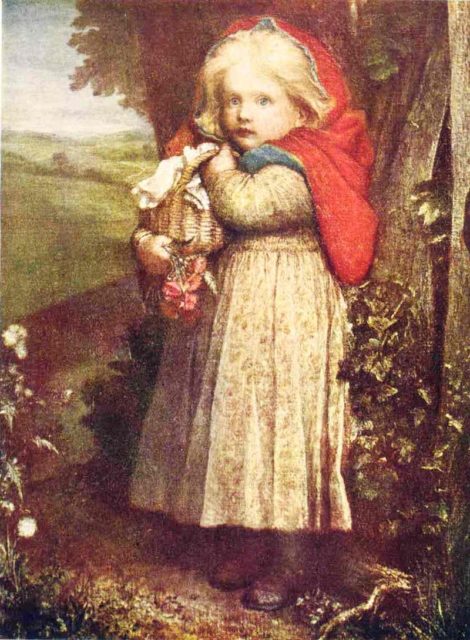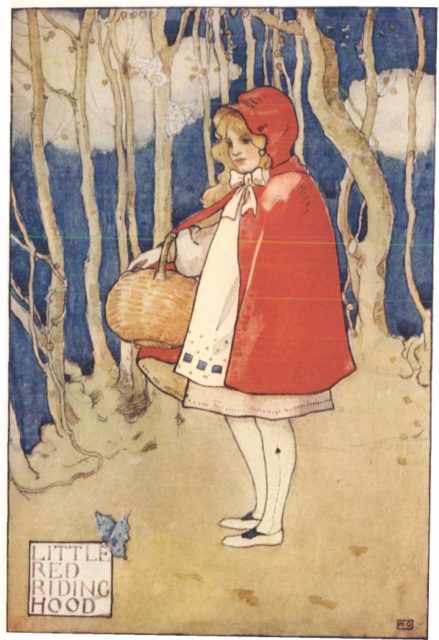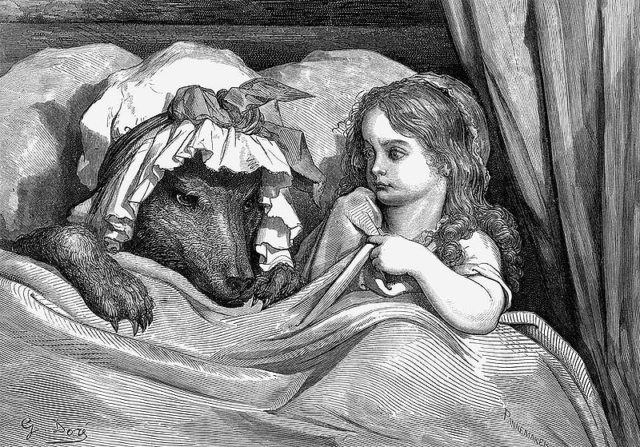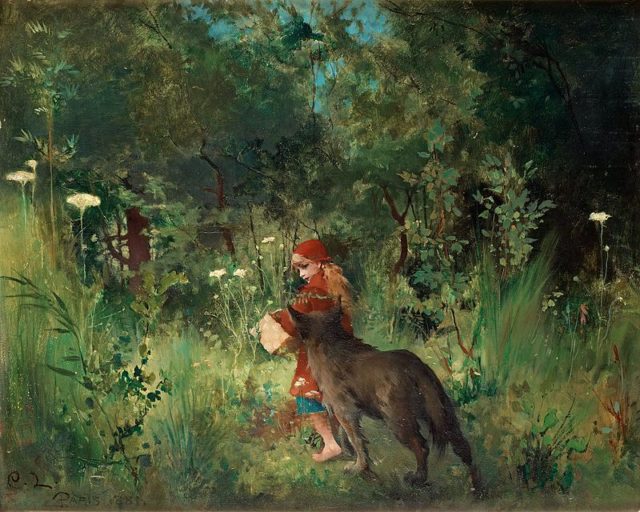
Here are examples of how these different Resistant Readings can be applied to the fairy tale of Little Red Riding Hood.
|
Little Red Riding Hood |
|||
|
Dominant |
Feminist |
Marxist |
Psychoanalytical |
|
Children should obey their parents because disobedience is dangerous. It is dangerous to talk to strangers. Females are vulnerable but can rely on men to protect them. Males are rescuers. Males are stronger than females and better able to protect themselves and others. |
There female figures fall into 3 clear stereotypes of what a woman should be: Mother is a carer; LRRH is a dutiful daughter; Grandma is a helpless victim.
The male figures are: the wolf – a predator who stalks the female child and the woodcutter – who is the typical male hero, rescuing the damsel.
Women are seen as people who should obey instructions. LRRH is implicitly criticized for disobeying her mother, when she was simply exercising childish curiosity.
Women, especially the young, are seen as prizes who can be taken by force.
|
LRRH, Grandma and Mother own property and have a comfortable life. The wolf is homeless and hungry.
Because of the women’s unwillingness to share, the wolf attempts to satisfy his hunger by taking what he needs to survive – in this case LRRH.
For breaking the rules of ownership, which only work in favour of the rich, the wolf is brutally murdered by a member of the proletariat (the woodcutter) who has been tricked into thinking that he is on the same side as the capitalist property owners.
Parental authority is reinforced as a way of instilling attitudes of submission to authority to help to preserve the structure of society. |
LRRH wears red, symbolizing the suppressed pedophiliac desires of male readers.
She enters a dark forest and gathers flowers, a subconscious expression of sexual desire – deflowering.
The wolf attacking LRRH from the bed is clearly suggestive of rape fantasies.
The woodcutter is a strong male father-figure representing an Electra complex on the part of LRRH, i.e. a sexual desire for her father which is clearly unacceptable and so has to be transferred to other men
The violent death of the wolf reinforces this as the father-figure symbolically emasculates his competitor for the child’s affections. |
http://mrhoyesibwebsite.com/Critical%20Theory/Reading%
20Against%20The%20Grain/Resistant%20Readings.htm)
Pre-critical: This is Red Riding Hood‘ first meeting with the Woolf. His human like stance and the wearing of a cloak that mimics the look of sheep‘s wool makes us wonder about the intentions of a ‗wolf in sheep‘s clothing.‘ While his words are polite and tender, the wolf‘s garb and how he leans into her space implies that he may pose danger—the danger Red Riding Hood‘s mother has warned her about.
Formalist: Red Riding Hood is ―obliging‖ in listening and the Wolf is ―tender‖ in speaking with her. A connection is being made and the fact that Red Riding Hood tells him ―all‖ indicates that she is surrendering to him. His familiarity in asking her to give his ―love‖ to her grandmother and his promise to call on her as soon as he can also illustrates an intimacy between the two of them.
Mythological/ Archetypal: The fact that this seduction by the wolf is occurring under a tree connects it with the devil‘s seduction of Eve in the Garden of Eden. Red Riding Hood is our Eve who is being tempted into knowledge of good and evil. Instead of following the orders of her mother (creator) she has been tempted to stop. The question is will she stay on the path or make take a bite from the proverbial apple and make her own choices.
Psychological: Eye contact is very important in the Wolf/maiden intimacy of this moment. The shadow, or the darker, unconscious self, our wolf villain and the heroine, the anima, or a man's ―soul image‖ gaze into each others eyes. Their eyes (I) are on the same plane, and they mirror each other with the casually crossed arms. The Wolf is anamorphized and friendly as if he had been waiting for her. The implication is that they are connected.
Feminist: An intimate gaze has been established but the wood staff separates them. This phallic symbol draws a clear line between them—one is masculine and one is feminine. The desires of the unconsciousness will not be fulfilled as the woodcutters; the moral guardians of the patriarchal system keep watch from the background.
Marxist: The fact that Red Riding Hood and the Wolf meet in the forest a place without society and its social designations means that they can meet as equals; however, the finer garb of Red Riding Hood‘s cloak suggests that she is attempting to associate herself with a higher class than the wolf or the two woodcutters who look on and inadvertently act as protectors.
Historical: Perrault and the Grimm versions of this tale were written with an upper class audience in mind, and so by dressing the Wolf in peasants clothing they signal that their audience is not to be associated with the wolf and his possibly nefarious intentions. Off he ran, and Red Riding Hood went on her way, But often she lingered and played, And made as she went quite a pretty nosegay With the wild flowers that grew in the glade. So as she ran from the path (against which she had been warned) Looking for flowers farther than she should. With each one, she saw a still prettier one for which she yearned And so got deeper and deeper into the wood.
To read more scenes and the analysis, click HERE.

Little Red Riding Hood is one of the most enduring children’s tales in existence. Childhood memorabilia can hold many fond memories, whether it’s the favorite teddy or the fluffy, irreplaceable blanket that we once snuggled with at bedtime. However, the most powerful reminders of our younger years can be the fairy tales we were told. Snow White and the Seven Dwarfs, Cinderella, Sleeping Beauty, Peter Pan, and numerous others have shaped our imagination and even worked as moral lessons filtered through the playful characters.
Yet when these fairy tales’ origins are researched, a deeper and darker tone is found in many of them. One such tale is the “Little Red Riding Hood.” The earlier versions of this story differ from the widely known Grimm Brothers version.
The popular version of this story presents a little girl with a hooded red cloak (according to the version of Perrault) or a cap instead of a hood (according to the Grimm version, known as Little Red-Cap). One day she goes to visit her sick grandmother and is approached by a wolf to whom she naively says where she is headed.

Little Red Riding Hood. Illustrated by Jessie Willcox Smith, 1911
In the most popular modern version of the fairy tale, the wolf distracts her and goes to the grandmother’s house, enters it, and eats her whole. Then, he disguises himself as the grandmother and waits for the girl, who is also attacked when she arrives. Next, the wolf falls asleep but a lumberjack hero appears and makes an opening in the wolf’s stomach with an ax. Little Red Riding Hood and her grandmother come out unharmed and put stones in the wolf’s body, so that when he awakens, he’s unable to flee and dies.

“Little Red Riding Hood” illustration by Arthur Rackham.
The origins of “Little Red Riding Hood” go back to the 10th century in France, where peasants told the story that was then passed along to the Italians, who were obviously enchanted by it. A few other versions with a similar title were created: “La Finta Nona” (The False Grandmother) or “The Story of Grandmother.” Here, the character of an ogre replaces the wolf that imitates the grandmother. Little Red is deceived into mistaking her granny’s teeth for rice, her flesh for steak, and her blood for wine, so she eats and drinks, and then jumps into bed with the beast and ends up getting gobbled up herself. Some versions include illicit implications and involve a scene where Little Red is asked by the wolf to take off her clothes and throw them in the fire.

Little Red Riding Hood by George Frederic Watts
Some folklorists have tracked down records of other French folk versions of the story, in which Little Red realizes the wolf’s attempted trickery and so she invents an I-desperately-gotta-use-the-bathroom-story to her grandmother in order to escape.
The wolf reluctantly approves but ties her with a string to prevent her from fleeing, but she still succeeds in escaping. Interestingly, these versions of the story depict Little Red Riding Hood as a courageous heroine who relies only on her wit to avoid the horror whereas the later “official” published versions by Perrault and Grimm include an older, male figure who saves her.

An engraving from the Cyclopedia of Wit and Humor.
Dr. Jamie Tehrani, a cultural anthropologist, found several versions of “Little Red Riding Hood” dating back almost 3,000 years. According to him, in Europe at least, the earliest version is a Greek fable from the 6th century BC, attributed to Aesop.

Little Red Riding Hood, illustrated in a 1927 story anthology
In China and Taiwan, there is a tale that resembles “Little Red Riding Hood.” It’s called “The Tiger Grandma” or “Grand Aunt Tigress,” and it dates back to the Qing Dynasty (1644-1912). The motif, idea, and characters are almost identical, but the main antagonist is a tiger instead of a wolf.

Gustave Doré’s engraving of the scene: “She was astonished to see how her grandmother looked”
The French folklorists and writer Perrault’s version of the story in the 17th century featured a young girl next door to a village who incredulously shares her grandmother’s address with a wolf. Next, the wolf exploits her naivety by asking her to get into the bed, where he then attacks and eats her.

Little Red Riding Hood 1881
This not so happy ending was later explained by Perrault himself, in order to cast any doubts away regarding the “moral” of the story. According to him, the story should be a forewarning for young, pretty girls to avoid strangers. Further, he noted that he chose a wolf to be a villain because wolves resembled people. Some of them might not be noisy or hateful but they deceive with their gentleness, enter the young girls’ homes and turn out to be fatal.

“The better to see you with”: woodcut by Walter Crane
Two centuries later, the Brothers Grimm rewrote Perrault’s tale but also created their own variant, named Little Red Cap, in which an animal-skin hunter saves the girl and her grandmother. The brothers wrote a volume of the story in which Little Red Riding Hood and her Granny encounter and do away with another wolf using a strategy supported by their previous experience. This time, Little Red ignored the wolf in the woods, Grandma didn’t let him enter, but when the wolf skulked around, they lured him with the smell of sausages from the chimney under which they previously put a manger filled with water.
The wolf plunged into it and drowned. In 1857, the Brothers Grimm concluded the tale as we know it today, reducing the somber undertones of other versions. Their practice was continued by the writers and adapters of the 20th century who, in the wake of deconstruction, Freudian analysis, and feminist critical theory, produced rather refined versions of the popular children’s fairy tale.
Magda Origjanska
https://www.thevintagenews.com/2018/03/09/little-red-riding-hood-2-2/?utm_source=penultimate